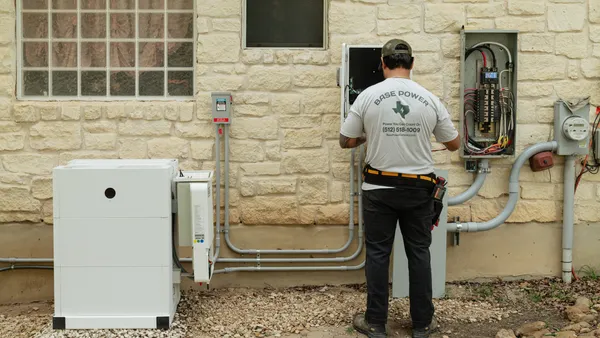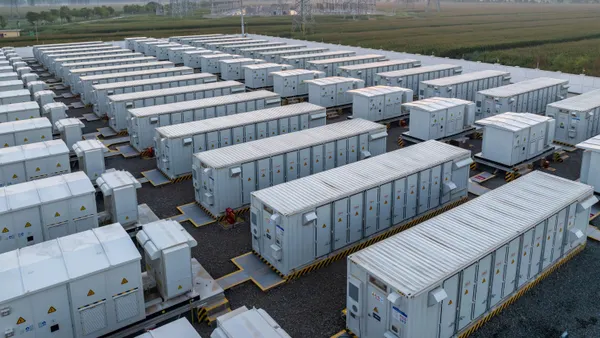Dive Brief:
- Two companies are planning to build the country’s first long-duration energy storage system based entirely on liquid air technology in northern Vermont in a bid to address transmission issues in the region.
-
The proposed project will be at least 50 MW, Highview Power Storage — the developer of the emerging technology — and Encore Renewable Energy announced on Wednesday. It will be capable of providing more than eight hours of storage, helping to integrate renewables into the grid and ensuring reliability during storms and other conditions.
-
But like any other new technology, liquid air storage will face “an uphill climb” to outcompete lithium-ion batteries, according to Daniel Finn-Foley, head of energy storage at Wood Mackenzie. “Lithium-ion really is the established player… that’s the biggest challenge,” he told Utility Dive.
Dive Insight:
Lithium-ion batteries have dominated the advanced energy storage market in recent years, but there is a broad understanding in the space that other technologies will become more competitive as the need for longer-duration storage grows, Finn-Foley told Utility Dive.
“That’s the sort of market niche that a lot of long-duration players, including Highview, are pursuing,” he said.
Liquid air storage involves cleaning and compressing air with excess or off-peak electricity, liquefying it and storing it in cold insulated tanks. During peak periods on the grid, the air is warmed, causing it to expand and turn a turbine, “thus generating energy that can be used at peak times when the sun is not shining and the wind is not blowing,” Highview Power Storage said in a press release.
The company has two liquid-air facilities in operation in the United Kingdom, but the Vermont project could be the first of its kind in the United States.
The project could have several potential benefits for the New England area, which has been facing transmission issues related to congestion on its wires, Salvatore Minopoli, vice president of Highview Power USA, told Utility Dive. During times of high congestion, “you can put that energy into our storage system — so that eliminates congestion, which reduces transmission costs,” he said. The technology would also reduce the need for building out more transmission lines. Storage systems can be sited close to load centers and then discharged to the grid, he added, creating the potential to save a lot of money on the transmission side.
The patented technology offers “a unique, cost effective solution for unleashing a greater amount of cost-efficient renewable energy generation in transmission constrained areas,” Encore Renewable Energy Founder and CEO Chad Farrell said in a statement. “It will also allow for fewer curtailments and provide important energy balancing services for the rapidly evolving modern grid; all of which are extremely important as we look to build the infrastructure required to support a robust clean energy economy.”
The facility is one of approximately eight liquid air storage projects that the company is planning to build in the United States. One of the technology’s biggest benefits is that the systems can be sited anywhere, Minopoli said — unlike pumped hydro, which requires a nearby water source, or compressed air that needs deep caverns. The technology’s main competition is lithium-ion batteries, but it has the advantage of being longer duration, he added.
“[Lithium-ion batteries] are more attractive under four hours,” he said, whereas liquid air technology is overall less expensive and requires a lot less space.
Lithium-ion batteries are capable of running for eight hours, according to Finn-Foley — but at a price. To double the amount of energy a system can store, the number of batteries in it must be doubled, which means almost doubling the costs.
“With other technologies, there’s the potential to take advantage of scale where lithium-ion can’t and that’s where a lot of these longer-duration systems are looking to make a dent,” he said.
A key hurdle that Minopoli foresees is changing mindsets to accept a different technology.
“So my biggest challenge really is to get the first big one on the ground in the U.S. — and then that challenge goes away,” he said.
Highview Power Storage is ahead of the curve given that it is already operating liquid air storage facilities in Europe, Finn-Foley said, which could give the company some leverage in the market. Many alternative technologies — like gravity-based storage and modular pumped hydro — are still in the demonstration phase and “it’s critical for any of these technology providers to get some big deployments under their belts to show that they’ve moved beyond demonstration and into commercial,” Finn-Foley said.
Highview Power Storage and Encore are in discussions with utilities and transmission grid operator customers regarding the potential of the planned project. Achieving a revenue agreement will be key, according to Finn-Foley. Utilities dealing with transmission constraints such as those in Vermont are likely to look at relatively established technologies for long-duration contracts — and so the biggest challenge for emerging technology providers is establishing themselves in the market, he said.
“It’s not at all clear to me that the utilities are going to immediately see the value of eight hours of storage, or how that economically pans out. This seems to be a relatively early stage of the process for me to be a true believer. I would want to see a direct agreement to see how eight hours of storage is valued compared to two hours or four hours,” he said.














